Landslides are associated with a displacement of masses of destabilized earth due to:
- Conditioning factors
- Morphological features: slope geometry (i.e. its height, length, shape, slope angle and aspect).
- Geological factors: nature of the soil parent materials or lithology (e.g.. clay, limestone, weak material, weathered material) and structure and discontinuities (e.g. bedding planes, schistosity and foliation planes, faults, fractures).
- Landcover: such as forest, natural grasslands, pastures, arable lands, permanent crops, bare rocks..
- Triggering factors:
- Physical processes: including earthquakes, volcanic eruptions, climatic conditions (abnormally heavy rainfalls, snow melt, freeze and thaw).
- Geomorphologic processes: such as fluvial or wave erosion at the toe of the slope, deposition, loading.
- Man-made processes: including terracing, vibration, deforestation, the exploitation of materials or water tables, excavation, road construction, mining and quarrying, loading.
The causes of landslides are thus generally multiple, a conjunction or superimposition of several factors.
Causes are also often divided into two large categories:
- Internal causes, which are related to resisting forces.
- They lead to the failure of the slope without the intervention of perceptible changes on the surface; they are in fact causes which reduce the material’s shear strength. The internal causes which condition the instability of a slope are geological factors, morphological features and climatic conditions.
- External causes, which are related to driving forces (e.g. gravity, water through flow, pressure).
- They determine an increase of the shear stresses by means of more or less evident modifications of slope morphology. Among these processes the following are particularly important: Undercutting due to the erosion of a watercourse or to the excavation for road construction, exploitation of quarries or open pits, overloading, removal of lateral support, lateral pressure, tectonic activity, effect of vegetation.
A slope is stable when the resisting forces are superior or equal to the driving forces (or destabilising forces). The ratio between resisting forces and driving forces is the Safety Factor. It is conventionally taken as the measure for the stability of a slope.
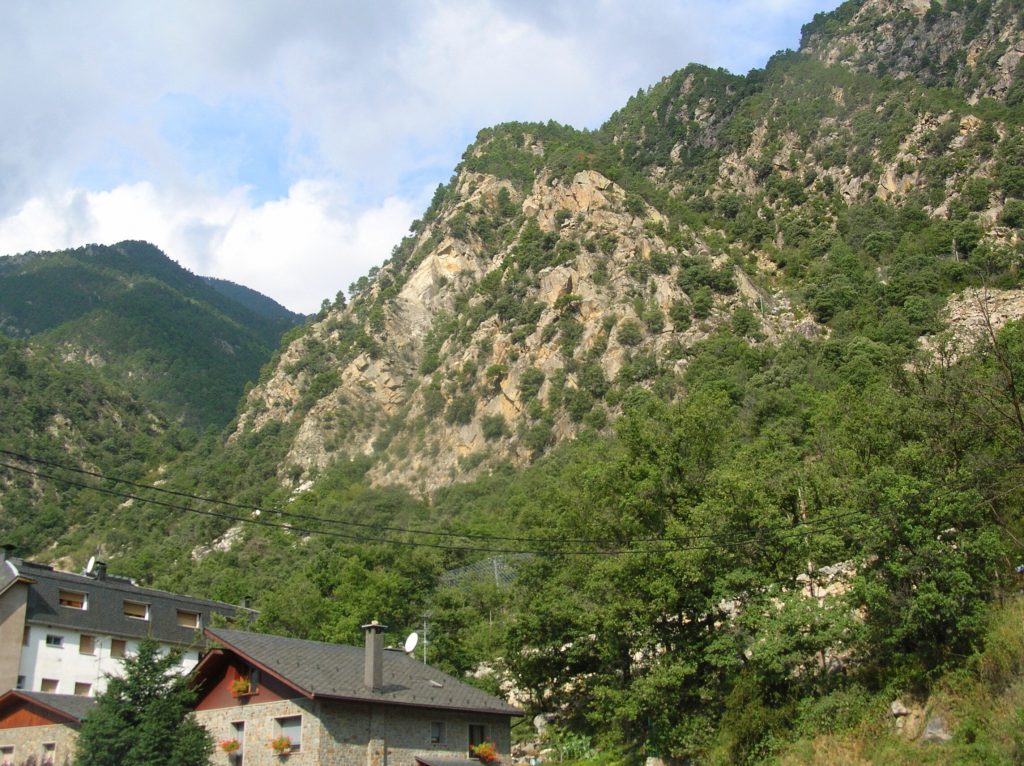

Solà d’Andorra la Vella (Andorra)
On 20th April 2008 during a heavy rainfall event, a rock mass was detached from a rock wall (photo above) generating hundreds of rock fragments. The two largest blocks overcame the fence located at the foot of the slope, one of them crashing into a warehouse.
(photo by D. Castaldini, september 2008)
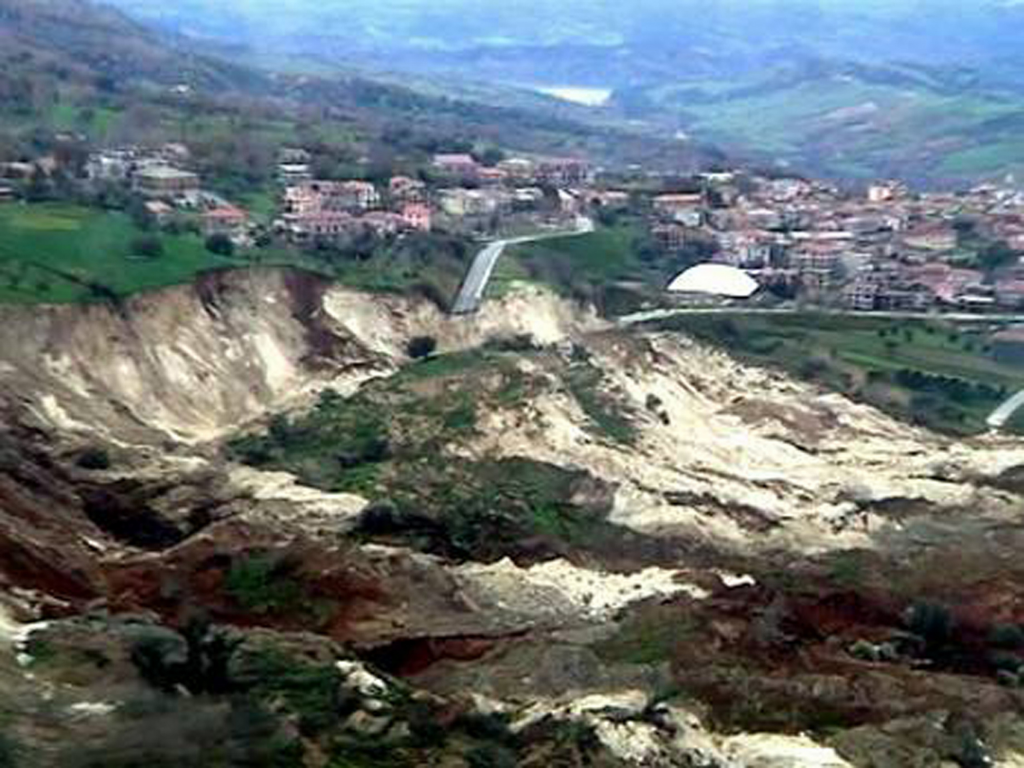
(photo by http://www.ansa.it/)
Fig. 1. The landslide near the southern Italian town of Maierato (Calabria region) which occurred on 15th February 2010 caused by heavy rains. No deaths or injuries have been reported, but about 2300 residents of the town were forced to evacuate when a section of hillside broke off burying their homes under rubble and debris. Though there were no injuries or deaths, relief workers on the scene described ”apocalyptic” devastation and said that Maierato had been reduced to a ”ghost town”. A video of the landslide shows the hillside slowly moving forward (e.g. see video at: http://daveslandslideblog.blogspot.com/2010/02/watch-this-extraordinary-landslide.html)
Landslides are associated with a displacement of masses of destabilized earth due to:
- Conditioning factors
- Morphological features: slope geometry (i.e., its height, length, shape, slope angle and aspect),
- Geological factors: nature of the soil parent materials or lithology (i.e. clay, limestone, weak material, weathered material etc.) and structure and discontinuities (bedding planes, schistosity and foliation planes, faults, fractures etc.), Landcover: forest, natural grasslands, pastures, arable lands, permanent crops, bare rocks, etc.
- Triggering factors:
- Physical processes: earthquakes, volcanic eruptions, climatic conditions (abnormally heavy rainfalls, snow melt, freeze and thaw etc.),
- Geomorphologic processes: fluvial or wave erosion at the toe of the slope, deposition, loading etc.
- Man-made processes: terracing, vibration, deforestation, the exploitation of materials or water tables, excavation, road construction, mining and quarrying, loading etc.
The causes of landslides are thus generally multiple, a conjunction or superimposition of several factors.
Causes are also often divided into two large categories:
- Internal causes, which are related to resisting forces.
- They lead to the failure of the slope without the intervention of perceptible changes on the surface; they are in fact causes which reduce the material’s shear strength. The internal causes which condition the instability of a slope are geological factors, morphological features and climatic conditions.
- External causes, which are related to driving forces (e.g. gravity, water through flow, pressure).
- They determine an increase of the shear stresses by means of more or less evident modifications of slope morphology. Among these processes the following are particularly important: Undercutting due to the erosion of a watercourse or to the excavation for road construction, exploitation of quarries or open pits, overloading, removal of lateral support, lateral pressure, tectonic activity, effect of vegetation.
A slope is stable when the resisting forces are superior or equal to the driving forces (or destabilising forces). The ratio between resisting forces and driving forces is the safety Factor. It is conventionally taken as the measure for the stability of a slope.

(photo by http://www.ansa.it/)
Fig. 1. The landslide near the southern Italian town of Maierato (Calabria region) which occurred on 15th february 2010 caused by heavy rains. No deaths or injuries have been reported, but about 2300 residents of the town were forced to evacuate when a section of hillside broke off burying their homes under rubble and debris. Though there were no injuries or deaths, relief workers on the scene described ”apocalyptic” devastation and said that Maierato had been reduced to a ”ghost town”. A video of the landslide shows the hillside slowly moving forward (e.g. see video at: http://daveslandslideblog.blogspot.com/2010/02/watch-this-extraordinary-landslide.html)
The role of water is significant but very varied. In the first instance it acts on the state or consistency of materials, for example, for clay and for an increase in water holding capacity, passage from a solid to a plastic and then to a liquid state. Secondly, the water transports material. Finally and most important, it acts on the underground water by means of the Archimedes thrust (Terzaghi’s law) which lifts or lightens the soil (Terzaghi, 1950). In the soil, the “Archimede thrust” is characterized by a decrease of effective normal stress (transmitted by the solid soil skeleton). The soil is lightened and the bulk unit weight is like: g – gw = g’
The consequence for the slopes is a decrease in the friction forces along the surfaces of the rupture, which promotes movement. Everyone can observe this phenomenon in the bath or in the swimming pool!

Effective normal stress (s’) Due to the decrease of the effective normal stress at the surface of the bathroom with the body, the man could easily move and fall down in the water!! The role of water may be appreciated by studying previous climatic conditions, both close and distant, which will contribute to feeding the water table (see case study: Villerville-Cricqueboeuf landslide IS MISSING).
By Alessandro Pasuto1, Mauro Soldati2, & Doriano Castaldini2
1 CNR – IRPI Padova (Italy)
2 Dipartimento di Scienze della Terra, Università di Modena e Reggio Emilia (Italy)
As regards the causes of mass movements, they can be divided into two large categories:
- internal causes: they lead to the failure of the slope without the intervention of perceptible changes on the surface; they are in fact causes which reduce the material’s shear strength;
- external causes: they determine an increase of the shear stresses by means of more or less evident modifications of slope morphology.
Naturally, the factors belonging to these two categories can be combined to varying extents so they do not fit in with any particular classification.
Let us now consider more in detail the internal causes which condition the stability of a slope.
- Geological factors.
- Morphological features.
- Climatic conditions.
As regards external causes which result in an increase of shear stresses, those processes giving rise to changes in slope geometry, mainly with an increase of the gradient, should first be considered. Among these processes the following are particularly important:
- Undercutting due to the erosion of a watercourse or to the excavation for road construction,
- Exploitation of quarries or open pits
- Overloading
- emoval of lateral support
- Lateral pressure
- Tectonic activity
- Effect of vegetation
External causes are related to driving forces (Geometrical changes, Unloading, Loading, Shocks and vibrations). They determine an increase of the shear stresses by means of more or less evident modifications of slope morphology. Internal causes are related to resisting forces (Progressive failure, Weathering, Seepage erosion, Water regime change). They lead to the failure of the slope without the intervention of perceptible changes on the surface; they are in fact causes which reduce the material’s shear strength
Geological factors.
They are given by all the primary characteristics that make up a slope, first of all lithology which includes both the rock’s mineralogical and textural composition and its structure. Among rock types more easily subject to disarrangement phenomena, clays are to be quoted, both those of primary origin and those derived from the meteoric weathering of volcanic materials. Argillaceous soils are particularly subject to instability phenomena such as flows.

Fig. 1: Superficial earth slide (Soil slip) in weathered volcanic materials at S. Cassiano, Dolomites, E Alps, Italy (photo by M. Marchetti)
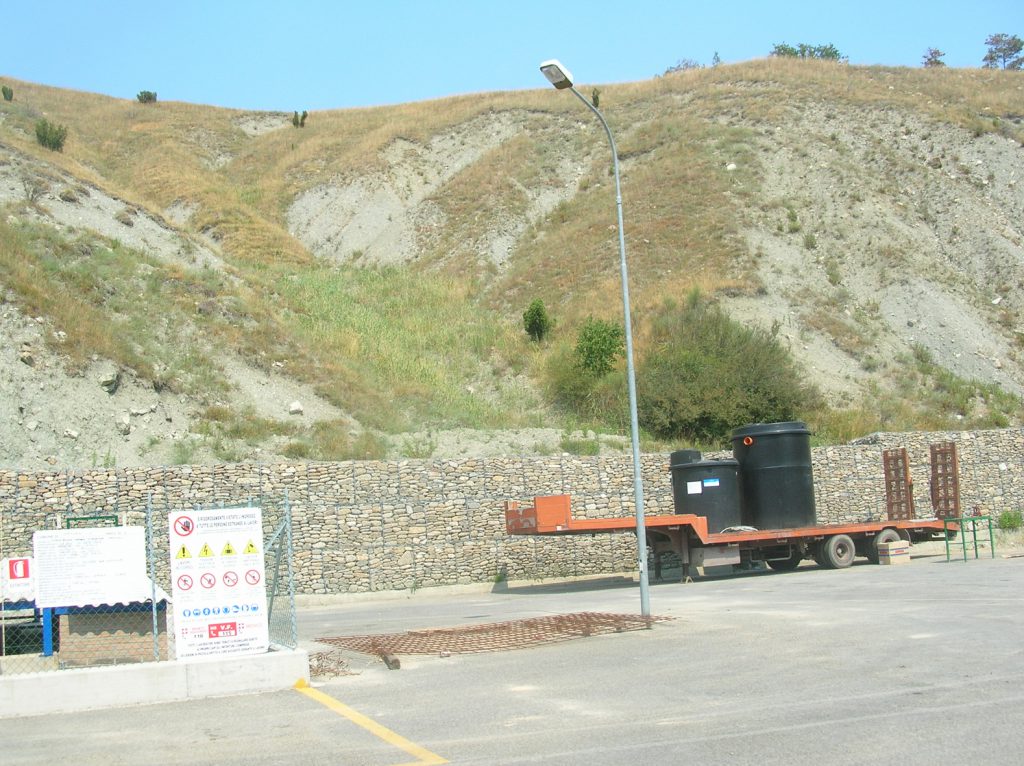
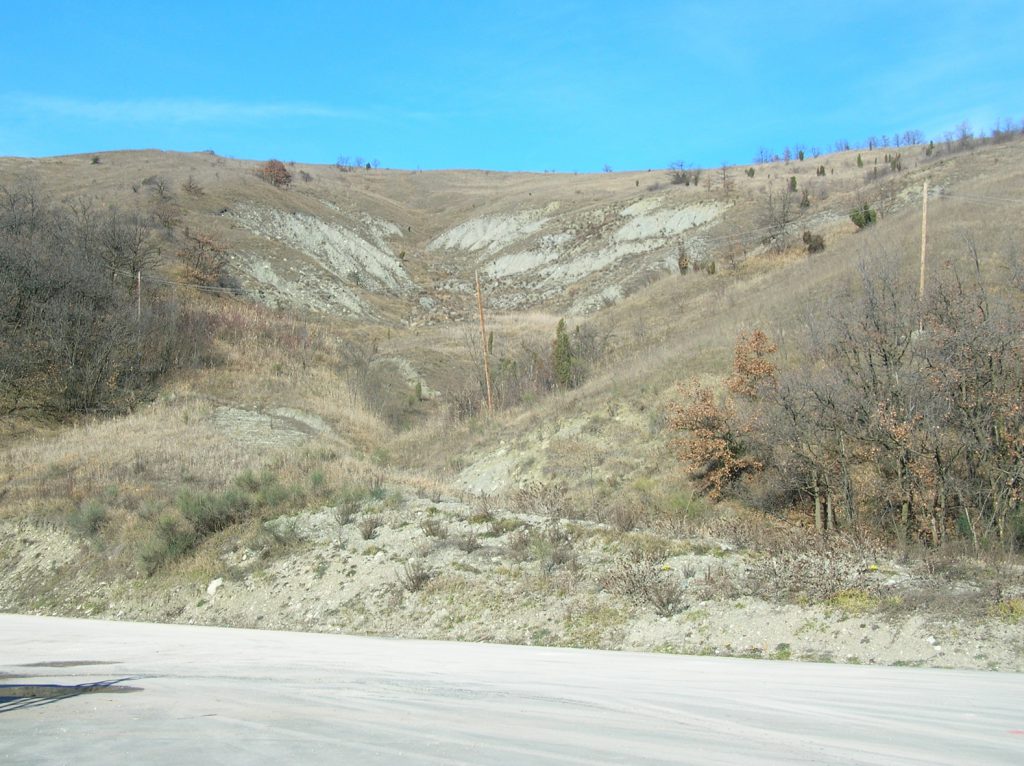
Fig. 2: Earth flows in clay materials in the Torrent Tiepido valley, Northern Apennines Italy (photos by D. Castaldini)
Also the structure of the formation involved is very important. For example, formations made up of alternating layers, such as flysch, where rock types showing ductile mechanical behaviour overlie brittle rocks, are usually subject to widespread and vast landslides. Also discontinuities, both primary (bedding planes) and secondary (schistosity and foliation planes), play an important role in the materials’ geomechanical behaviour especially with regard to mass movements such as the attitude of layers (low-angle dip-downstream beds will generally be more prone to sliding than dip-upstream levels).
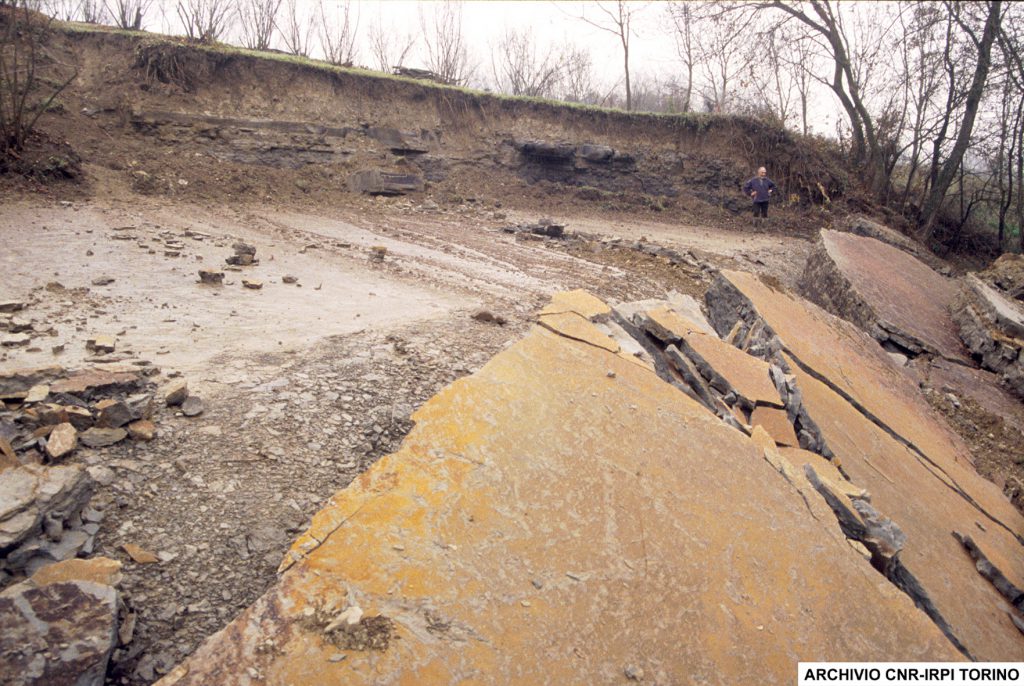
Of course, all these intrinsic characteristics of the materials can undergo changes of varying intensity and rapidity during the stages of a slope’s evolution. In fact, certain kinds of processes which to some extent modify the materials’ chemico-physical characteristics can take place, causing a consequent decrease of shear strength. Among geological factors, also the tectonic history of the slope should be considered. The presence of important structural discontinuities such as faults, fractures, cleavage, joints, slickenside or even folds, fault-folds etc. induce an intrinsic weakness of the internal bonds thus making the slope particularly prone to landsliding.

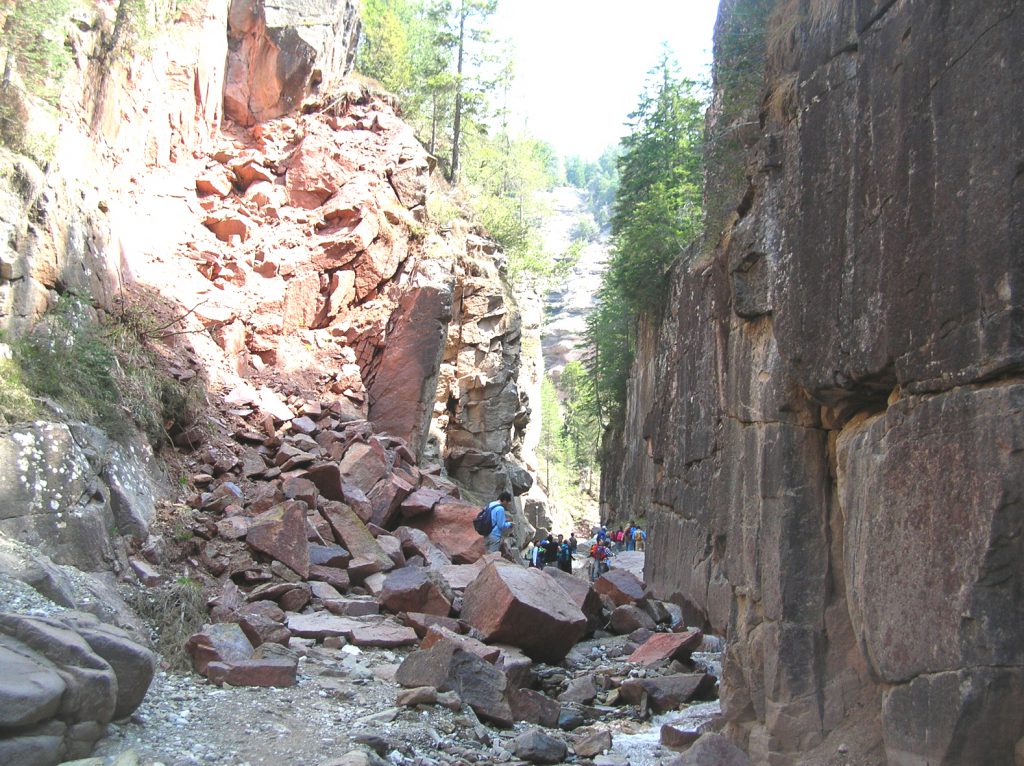
Fig. 4: Rock fall (below) in fractured volcanic formation (above) at Bletterbach Gorge, Northern Italy (photos by D. Castaldini)
Morphological features.
They include first of all the slope geometry, i.e. its height, length, shape, slope angle and aspect. The influence of the slope gradient is quite evident with respect to stability; indeed, very vast and steep slopes are more predisposed to disarrangement; on the other hand, even low-angle slopes can be subject to particular types of landsliding such as, for example, flows.
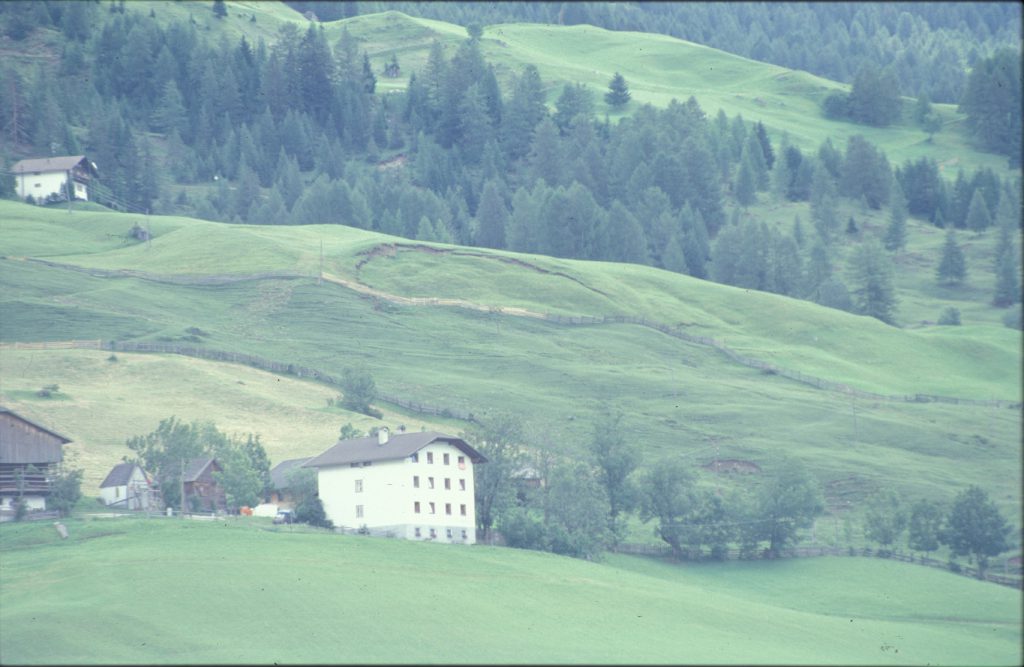
Climatic conditions.
Although there are several climatic parameters playing some role in the starting of landslides, the most important one is without doubt rainfall. Rainfall should be considered not only as the triggering pluviometric event (considering therefore only its intensity) but also as the amount of rain falling and accumulating during a certain period (considering also the length of time). If the percolation velocity is low, the rainfall duration assumes predominant importance for the triggering of the movement; on the contrary, in soils characterised by high hydraulic conductivity the function played by rainfall intensity becomes of paramount importance. The role of water mainly consists of an increase in porewater pressures caused by variations of the groundwater level. The cyclicity of these changes is a determining factor in weakening the internal bonds of the materials making up the slope. The influence of the various types of rainfall will of course be different according to the type of landslide. (go to 3.1.1 More details on the role of water)
Therefore, intense and time-concentrated rainfall will be particularly effective in triggering spatially limited movements such as debris flows, soil slips, mud flows, whilst prolonged precipitations could mainly give rise to slides and complex phenomena.
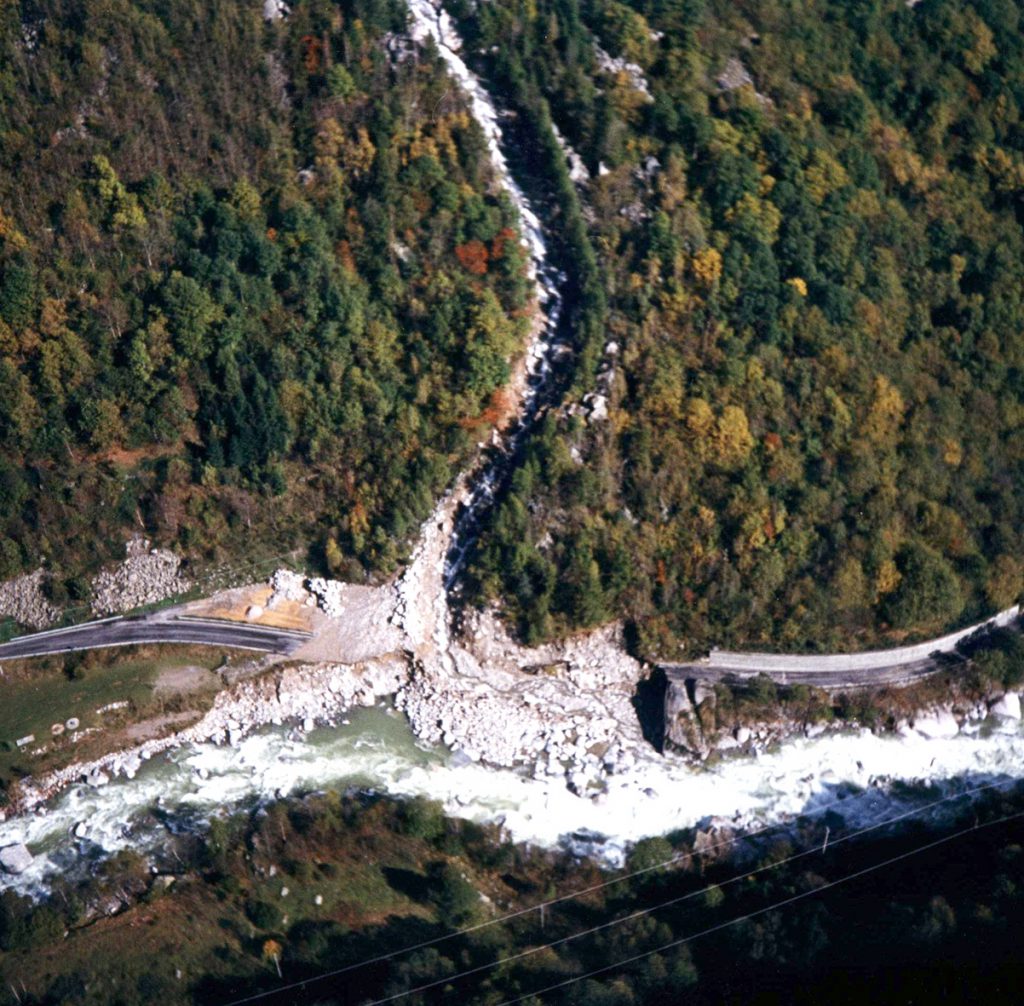

Fig. 6: Examples of debris flow and soil slip, following an intense rainy period in autumn 1994, which caused roads interruptions Piemonte Region, NW Italy) (photos by F. Luino)

As regards external causes which result in an increase of shear stresses, those processes giving rise to changes in slope geometry, mainly with an increase of the gradient, should first be considered. Among these processes the following are particularly important:
- Undercutting due to the erosion of a watercourse or to the excavation for road construction,
- Exploitation of quarries or open pits
- Overloading
- Removal of lateral support
- Lateral pressure
- Tectonic activity
- Effect of vegetation
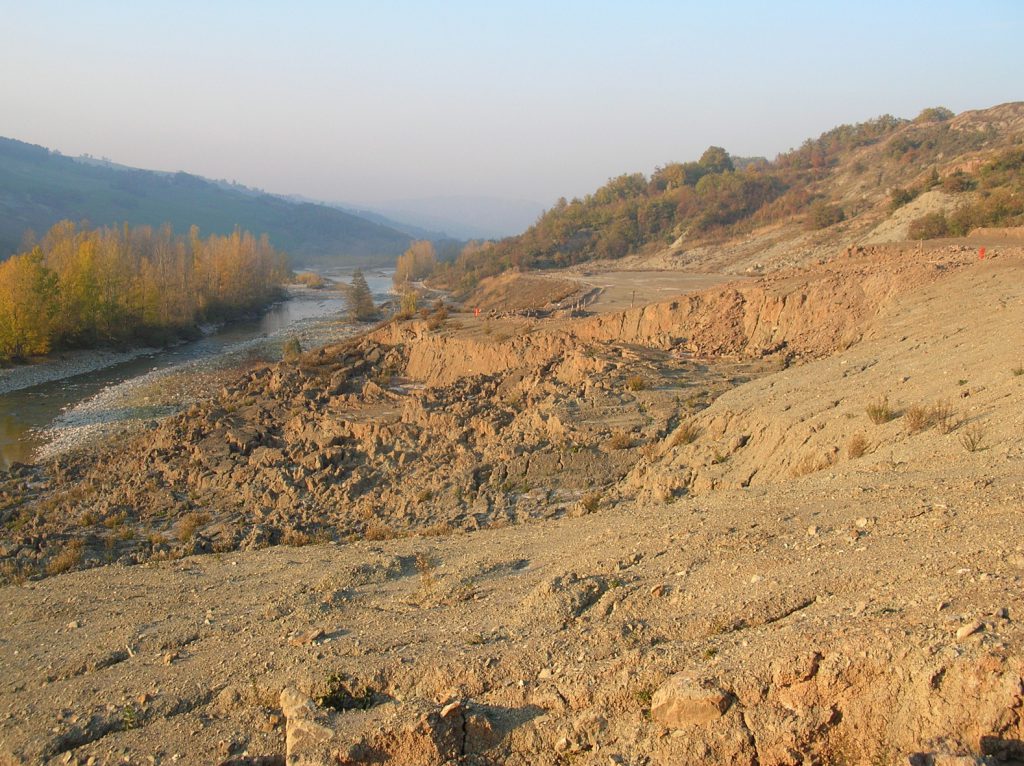
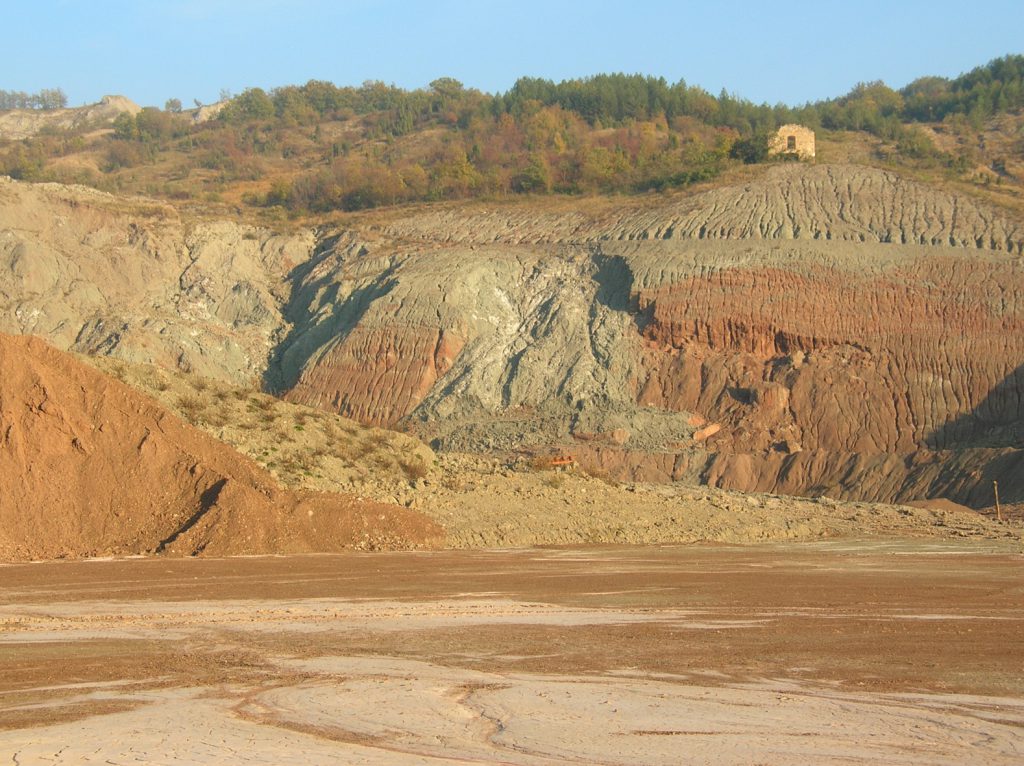
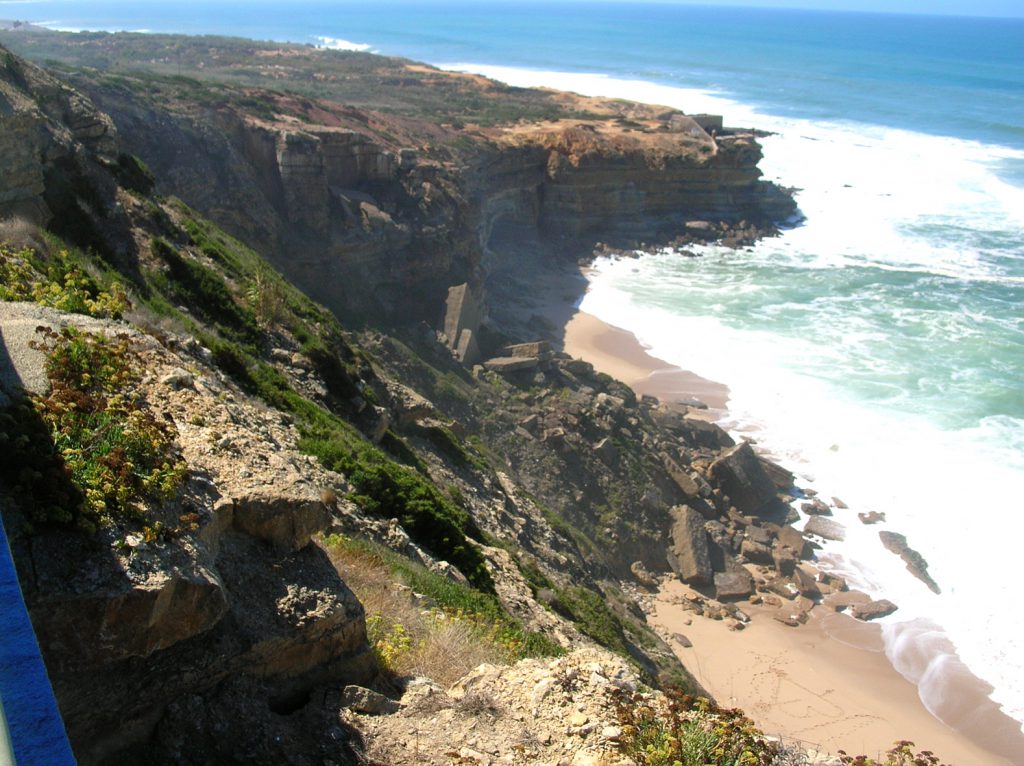
Slope geometry can change also because of phenomena taking place underground: for example, the formation of large cavities owing to mineral chemical solution or squeezing out of underlying ductile materials.
Overloading can be another phenomenon inducing an increase of applied shear stresses. This can happen owing to both natural causes, such as soil imbibition by rain or snow melt, accumulation of materials from volcanic eruptions, avalanches, debris flow or other movements, types of vegetation etc., or human activities as, for example, in embankment construction, buildings or other structures, in accumulation of tailings from mines and pits or in lacustrine basins or artificial reservoirs.
Also the removal of lateral support exerting a counterthrust on the slope could be a cause of unbalance. For example, a glacier’s withdrawal is one of the most frequent causes which determined vast post-glacial landslides in the Alps. To this category also tectonic phenomena such as activities along fault planes and subsidence should be ascribed, besides gravitational movements themselves. It is, in fact, obvious that the detachment of a portion of slope induces in the in-place material a redistribution of the stresses which can eventually cause a new movement.
Another factor which can favour the development of mass movements is lateral pressure. It can be exerted by water percolating into joints or by ice; also swellings due to hydratation could induce considerable lateral pressures as well as the mobilisation of residual tectonic stresses.
Tectonic activity can be a direct cause of slope movements in the case of regional tilting or uplift. Also in this case the effect of the tectonic process takes place essentially by means of an increase of the slope gradient. Finally, superficial deformations induced by volcanic processes can increase the shear stress within a slope also locally.
A particular discussion should be reserved for seismic shocks and other transitory stresses such as vibrations induced by operating machines, explosions, rock falls etc. These events can cause both a reduction of the materials’ shear strength and an increase, although temporary, of shear stresses. The former can be exemplified by phenomena such as liquefaction induced by sudden, cyclic increases of porewater pressures with a consequent instantaneous decline of the soil’s resistance and the collapse of the slope. This happens most frequently in saturated cohesionless medium-fine materials such as sands, silts, clays etc. The increase of shear stresses is on the contrary linked to both the accelerations to which the materials are submitted during vibrations and the temporary increment of the gradient angle in unstable slopes.
One of the first earthquake-triggered landslide was documented as early as 372-373 B.C. when Helice, a Greek city on the northern coast of the Peloponnese, slid into the sea after having been razed to the ground.
Thousands other examples occurred in historical and recent times. For instance the earthquake that occurred in Friuli (eastern Italy) on 6th May, 1976, with a main shock of magnitude 6.4 and intensity IX-X (Mercalli scale), produced numerous landslides activated; they mainly consisted of rock falls and, to a lesser extent, block-slides.


Fig. 11: Landslides induced by the earthquake which occurred in Friuli (North- Eastern Italy) on 6th May, 1976, magnitude 6.4, intensity IX-X (photos by M. Panizza)
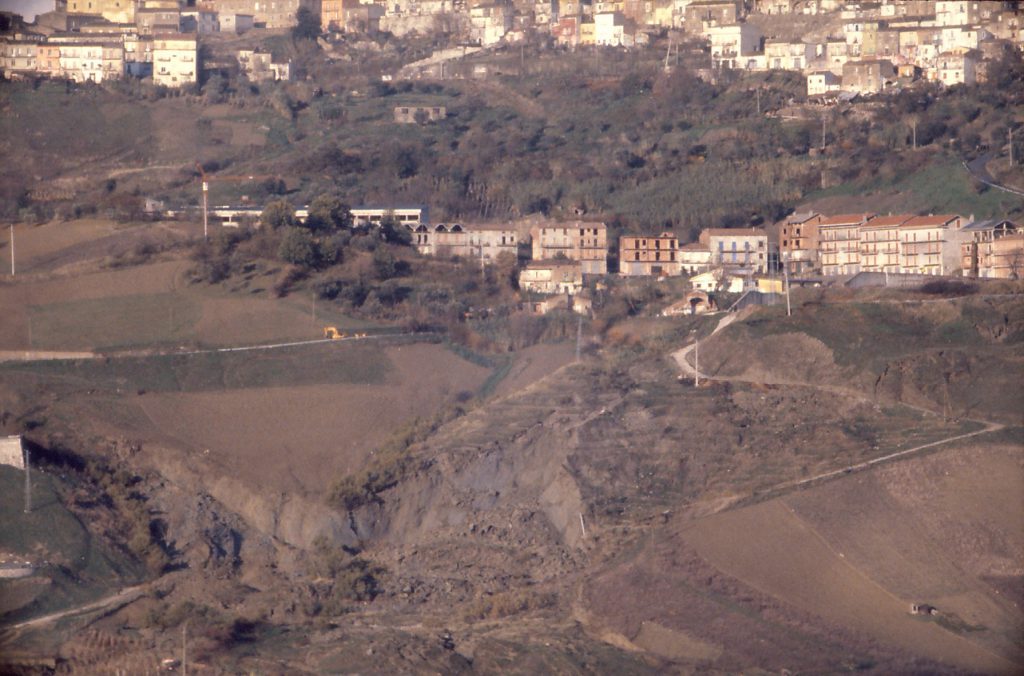
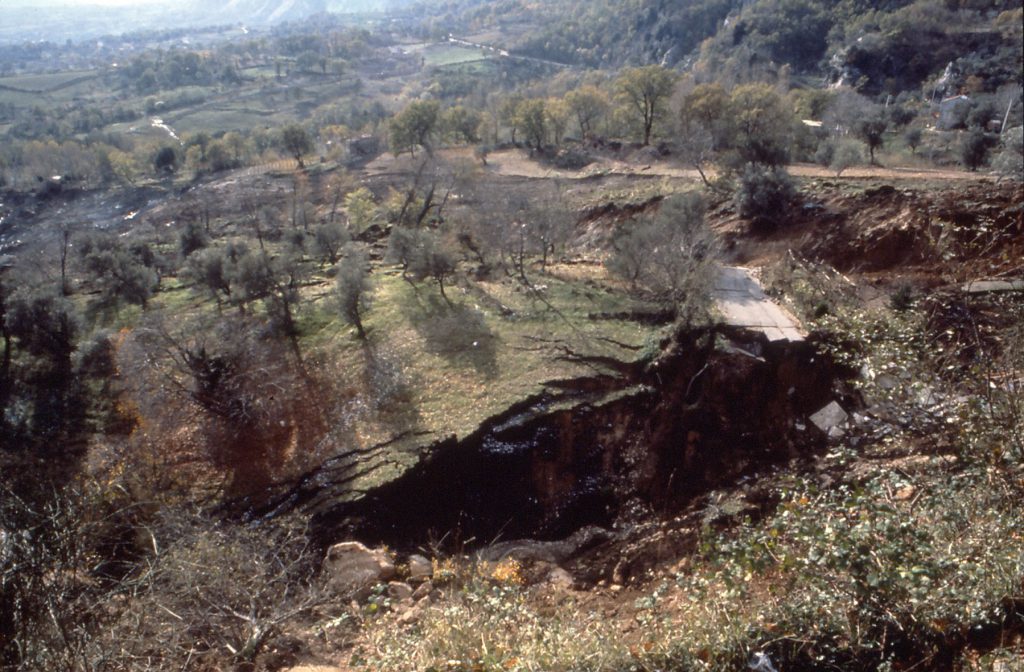
Fig. 12: Landslides induced by the earthquake which occurred in Campania and Basilicata (Southern Italy) on 23rd November 1980, magnitude 6.8, intensity X (photos by M. Panizza)
Finally, the effect of vegetation on slope stability may be twofold: sometimes it promotes stability by reducing the action of climatic agents on the slopes, protecting the soil from precipitations, wind and sunshine; it retains a considerable amount of rain water by means of leaves, branches etc. and eliminates water through evapotranspiration; runoff and erosion decrease and there is an increase in shear resistance of the slope thanks to the roots. On the other hand, the presence of vegetation may originate negative effects by increasing the load on slopes, enhancing the action of wind forces on the trees and disjointing the soil through the action of tree roots which widen cracks and favour infiltration.
References:
PASUTO S. and SOLDATI M. Landslide Hazard in PANIZZA M (1996). Environmental Geomorphology. Developments in Earth Surface Processes 4. Elsevier Science B.V., 180 -187, Amsterdam.
A slope is stable when the resisting forces are superior or equal to the driving forces (or destabilising forces). The ratio between resisting forces and driving forces is the safety factor F. It is conventionally taken as the measure for the stability of a slope. Parameters involved in calculation of the safety factor can be summarized with figure 1 (from Besson, 2005):

With:
Sumo is the overload
The other man is the thrust force
P: weight of material (force)
Zoom corresponds to the characteristic of the slipping contact surfaces
Resisting forces:
Pn: normal component of P
Normal component of the overload (Pn)
Normal component of the thrust force (Pn)
Driving forces (or destabilising forces):
Pt: tangential component of P
U1 and U2: hydrostatic pressure due to the “Archimedes thrust”
E: flow pressure
Tangential component of the overload (Pt)
Tangential component of the thrust force (Pt)
The safety factor is also defined as the ratio between shear stress and shear strength in a loaded mass:
F =1//0
With = available shear strength and 0 = shear stress at the speed of 0
Shear strength: cohesion and effective inter-particle friction; internal resistance of a material to shear stress. The shear strength is function of temperature, confining pressure, shape, size, loading rate and amount of pores. It is an important parameter in the determination of engineering and geomorphic properties of materials.
Shear stress: two perpendicular loads or stresses applied tangential to the surface of material, producing angular deformation in the material.
A safety factor less than or equal to1 indicates that the slope is instable. Indeed, as the shear stress approaches the maximum available shear strength, the safety factor becomes 1 and failure is imminent. If the slope is destabilized by triggering factors (earthquake, rainfall, etc.), the apparent increase of the shear stress over the available shear strength is equivalent to the acceleration of the sliding mass. Three stages can be distinguished (figure 2):
- Stable, F>1,5: the margin of stability of the slope is sufficiently high to withstand all destabilising forces;
- Marginally stable, 1,0
- Actively unstable, F~1,0: destabilising forces produce acceleration of the sliding mass (continuous or intermittent movements).
Moreover, safety factor value is time-dependent (figure 2). The movement phase is split into pre-failure, failure and post-failure stages with the possibilities of occasional reactivation. All types of movements at a given stage are associated with specific controlling variables that are subdivided into predisposition and triggering factors. Slope instability responds to a combination of these factors. The predisposition factors change most times only gradually over time whereas the triggering factors are transient. Triggering factors may either increase the shear stress, decrease the shear strength of the material or both.

References:
BESSON L., 2005. Les risques naturels: de la connaissance pratique à la gestion administrative. Editions Techni. Cités, Voiron, 60 p.
VAN ASCH T., MALET J.P., VAN BEEK L., AMITRANO D., 2007. Techniques, issues and advances in numerical modelling of landslide hazard. Bulletin de la société géologique de France, n°178, p. 265-288